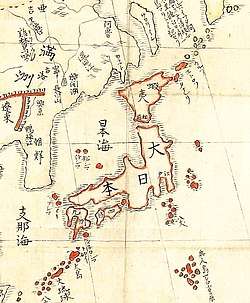Jōwa (Heian period)
Jōwa (承和) was a Japanese era name (年号, nengō, "year name") after Tenchō and before Kashō. This period spanned the years from January 834 through July 848.[1] The reigning emperors were Junna-tennō (淳和天皇) and Ninmyō-tennō (仁明天皇).[2]
| History of Japan |
|---|
 |
Change of era
- February 14, 834 Jōwa gannen (承和元年): The new era name was created to mark an event or series of events. The previous era ended and the new one commenced in Tenchō 10, on the 3rd day of the 1st month of 834.[3]
Events of the Jōwa era
- 834 (Jōwa 1): Emperor Ninmyō planted a cherry tree near the shishinden to replace the tree Emperor Kanmu had planted at the time the capital was established in Kyoto.[4]
- 834 (Jōwa 1): Kūkai is given permission to establish a Shingon chapel at the Imperial Palace.[5]
- June 11, 840 (Jōwa 7, 8th day of the 5th month): The former-Emperor Junna died at the age of 55.[3]
- 843 (Jōwa 10): Work was completed on the multi-volume Nihon Kōki.[6]
By the Jōwa era, the formality of male promotions (Dansei jōi) were announced by the seventh day of each new year, while those for women (Onna jōi) were announced on the eighth day.[7]
Notes
- Nussbaum, Louis-Frédéric. (2005). "Jōwa" in Japan Encyclopedia, p. 434, p. 434, at Google Books; n.b., Louis-Frédéric is pseudonym of Louis-Frédéric Nussbaum, see Deutsche Nationalbibliothek Authority File.
- Titsingh, Isaac. (1834). Annales empereurs du Japon, pp. 106–112; Brown, Delmer et al. (1979). Gukanshō, pp.283--.284; Varley, H. Paul. (1980). Jinnō Shōtōki, p. 164-165.
- Brown, p. 284.
- Ponsonby-Fane, Richard A.B. (1956). Kyoto: the Old Capital of Japan, p. 63.
- Kukai. (1972). Kūkai: Major Works (S. Hakeda, editor), p. 59., p. 59, at Google Books
- Nussbaum, "Nihon Kōki" in p. 709, p. 709, at Google Books.
- Ko, Dorothy et al. (2003). Women and Confucian Cultures in Premodern China, Korea, and Japan, p. 74 n66.
gollark: ddg! heavserver
gollark: ddg! heavserber
gollark: @discord team bad
gollark: Thus discord team bad?
gollark: The bot can just do it programmatically.
References
- Brown, Delmer M. and Ichirō Ishida, eds. (1979). Gukanshō: The Future and the Past. Berkeley: University of California Press. ISBN 978-0-520-03460-0; OCLC 251325323
- Ko, Dorothy, JaHyun Kim Haboush and Joan R. Piggott. (2003). Women and Confucian Cultures in Premodern China, Korea, and Japan. . Berkeley: University of California Press. ISBN 9780520231054; ISBN 9780520231382; OCLC 249343721
- Nussbaum, Louis-Frédéric and Käthe Roth. (2005). Japan encyclopedia. Cambridge: Harvard University Press. ISBN 978-0-674-01753-5; OCLC 58053128
- Titsingh, Isaac. (1834). Nihon Ōdai Ichiran; ou, Annales des empereurs du Japon. Paris: Royal Asiatic Society, Oriental Translation Fund of Great Britain and Ireland. OCLC 5850691
- Varley, H. Paul. (1980). A Chronicle of Gods and Sovereigns: Jinnō Shōtōki of Kitabatake Chikafusa. New York: Columbia University Press. ISBN 9780231049405; OCLC 6042764
External links
- National Diet Library, "The Japanese Calendar" -- historical overview plus illustrative images from library's collection
| Preceded by Tenchō |
Era or nengō Jōwa 834–848 |
Succeeded by Kashō |
This article is issued from Wikipedia. The text is licensed under Creative Commons - Attribution - Sharealike. Additional terms may apply for the media files.